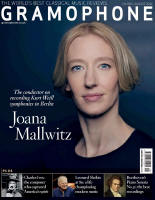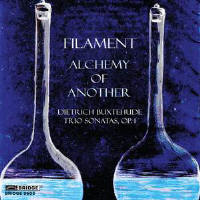Texte paru dans: / Appeared in:
|
|
|
|
|
|
Lindsay Kemp Recordings of Buxtehude’s trio sonatas enjoy a healthy presence in the catalogue these days, no doubt because their unusual scoring for violin, viola da gamba and harpsichord is an alluring one for small ensembles, and because their successful mingling of stylus phantasticus changeability with north European formal control and harmonic resource is a pleasing change from the inevitable four-movement slow-fast-slow-fast model that would begin its domination within a few years of their publication in the 1690s. And, as Philadelphia-based trio Filament show here, they have a bold character of their own as well.
They choose their own order for the seven sonatas of Op 1, starting with No 3 perhaps for the impact of its moody Adagio opening. That it and the following Allegro are not among the string-players’ most comfortable moments is a pity, especially if it were to put impatient listeners off going further. The music is worth staying for of course, but so, it turns out, are the performances, which capture a lot of the edgy life these pieces have to offer. Already by the end of No 3 we have a delicious downward ‘drag’, beautifully set up by the players, after which No 1 goes about its business with a nicely judged loose energy which somehow works even for its curious fanfare section (in which harpsichordist John Waldhausen lets loose some rolling arpeggios). They may not quite reach the full fits of fantasy available in the Biber-ish No 6, but they do not miss the apprehensiveness of the stops and starts at the beginning, nor the anguish in the slow interruptions to the Presto finale. The catchy ostinato movement that opens No 4 has made it the most familiar of Buxtehude’s sonatas, and Filament play it brisk, bright and light, its dialogue between violin and gamba truly engaging, and follow it up with a longingly plaintive Lento. The violin line in the Sarabande of No 5 is tastefully paced and ornamented by Evan Few, and Elena Kauffman lets her gamba speak with lyrical fervour when the occasion demands.
The recorded sound offers a slightly hollow and receded harpsichord tone, and overall is slightly on the dry side. It gives clarity and point to the textures that communicates more than do the relatively timorous Ensemble Spinoza (Navona, 11/23), but means that the performances do not sound as rich and fluid as the fine versions by the boisterous Ton Koopman and friends (Challenge Classics, 9/11) or the quiet but confidently elegant Arcangelo (Alpha, A/17). Filament certainly offer a viable alternative, however, with their interpretative intelligence and spark. |
|




